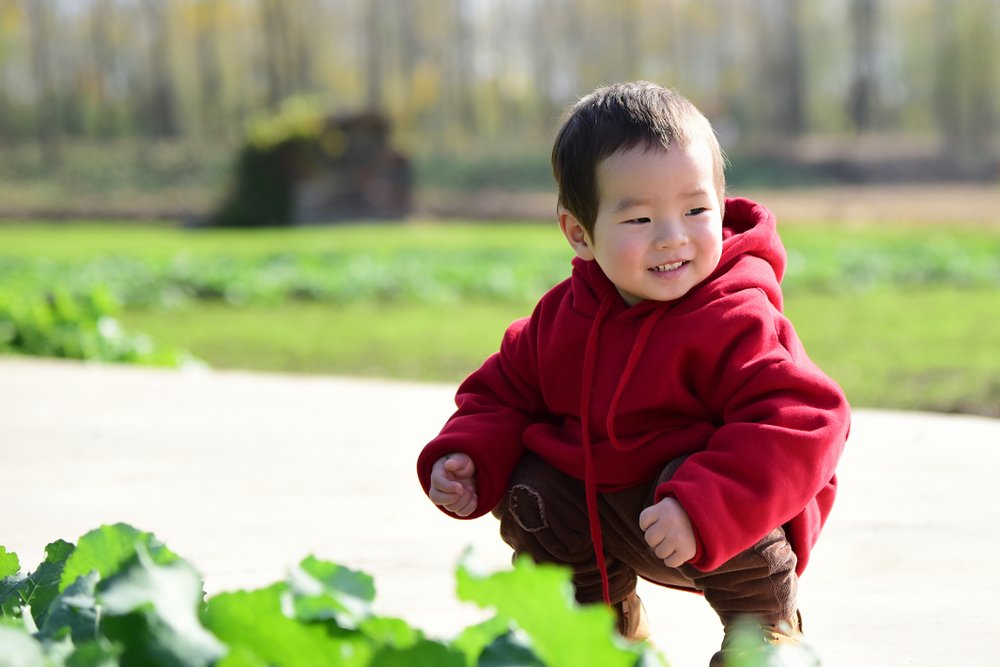Key points:
1. By 12-14 months, your baby can go from standing to squatting, showcasing balance.
2. They develop neck muscles to maintain their balance, enabling them to squat to reach objects.
3. At this age, they’ll squat to play independently with objects.
4. As they stay balanced while playing, they’re building the strength for independent standing.
In Part 1 and Part 2 of this article, we discussed some of the first milestones that your little one will accomplish when it comes to standing up. Now, we’ll continue with the ones that they will accomplish later on. You will probably notice these when they are between 12 and 14 months old, and some might even be accompanied by their first steps!
Goes from standing up to squatting
This means your little one has developed a great amount of balance! They’ve been working on it for a while now, and it’s not such an easy task.
At this age, your child’s center of balance is located on a different spot than ours. Why? It has to do with their head; it represents a larger percentage of weight than it does on the body of an adult. They need to have strong neck muscles to keep their neck straight and center their head. All that tummy time will be paying off!
This is related to the emblematic squatting position toddlers can perform. You have probably witnessed occasions in which your child is standing up and then spots something interesting on the floor that triggers their curiosity. They will try to reach the object and grab it from the floor. To do this, they’ll bend their knees all the way, squatting to a position you might find impossible to reproduce yourself!
This is also a major move towards independence, as they can now grab toys and objects on their own. There’s not an actual need to teach them how to do this, it will naturally kick in when you cover the floor with different toys. Don’t worry, they will start practicing until they are able to accomplish it all on their own.
When they are about 14 months old, they will probably manage to do it the other way around; now moving from a squat to standing. This will require even more strength! But before that, they might’ve just changed to a sitting position after squatting.
Stays balanced while standing up and playing with an object
We have discussed the importance of holding on to objects when standing or walking and how it helps your little keep their balance. With this new milestone, your little one is not only holding an object, they are playing with it! It might seem like a small change, but it takes so much more balance to be able to focus on playing, while also keeping a standing position.
After they manage to pull themselves up, the next step is to keep their balance while standing up. At first, their stand might look wobbly and make you feel a bit nervous. Don’t worry, they are actually more in control than they appear to be, that’s when holding objects comes in handy. We have talked about this before.
Be careful not to take the toy away! It makes perfect sense that if you see them walking clumsily while holding an object, you’d think they are wobbling because of it. Turns out it is the other way around! Without an object to hold on to, they can go right back to being unstable. This shows that, even though they are still in development, they have more control when standing up than it may seem.
A study that followed 13 kids, analyzed their standing time, movement, and stability. They took the holding of an object as one of the variables and were able to conclude that the toddlers presented better balance when they held on to something. This ability to multitask, when balance is so new, amazed the researchers.
Stays balanced while standing without any help
It’s finally here! Now your child is able to stand up all by themselves and hold that position. In order for this to happen, your little one needs enough muscle strength in their legs, hips, head, and tummy to keep their balance. These muscles have been building up while reaching previous milestones. Not all of them are directly related to standing up, but have to do with head control, rolling over, sitting, pulling themselves up, etc.
You can help them reach this milestone by encouraging them to interact with other babies that are already standing up and giving them time to play freely on the floor. The more exercise they do, the sooner they’ll be strong enough to stand up!
Cheer them once they accomplish this, so they don’t feel scared. If they relate standing up to clapping and excitement, they will feel motivated to keep trying. Standing up is an important precursor of walking, so stay close to your child and enjoy these beautiful moments together.








